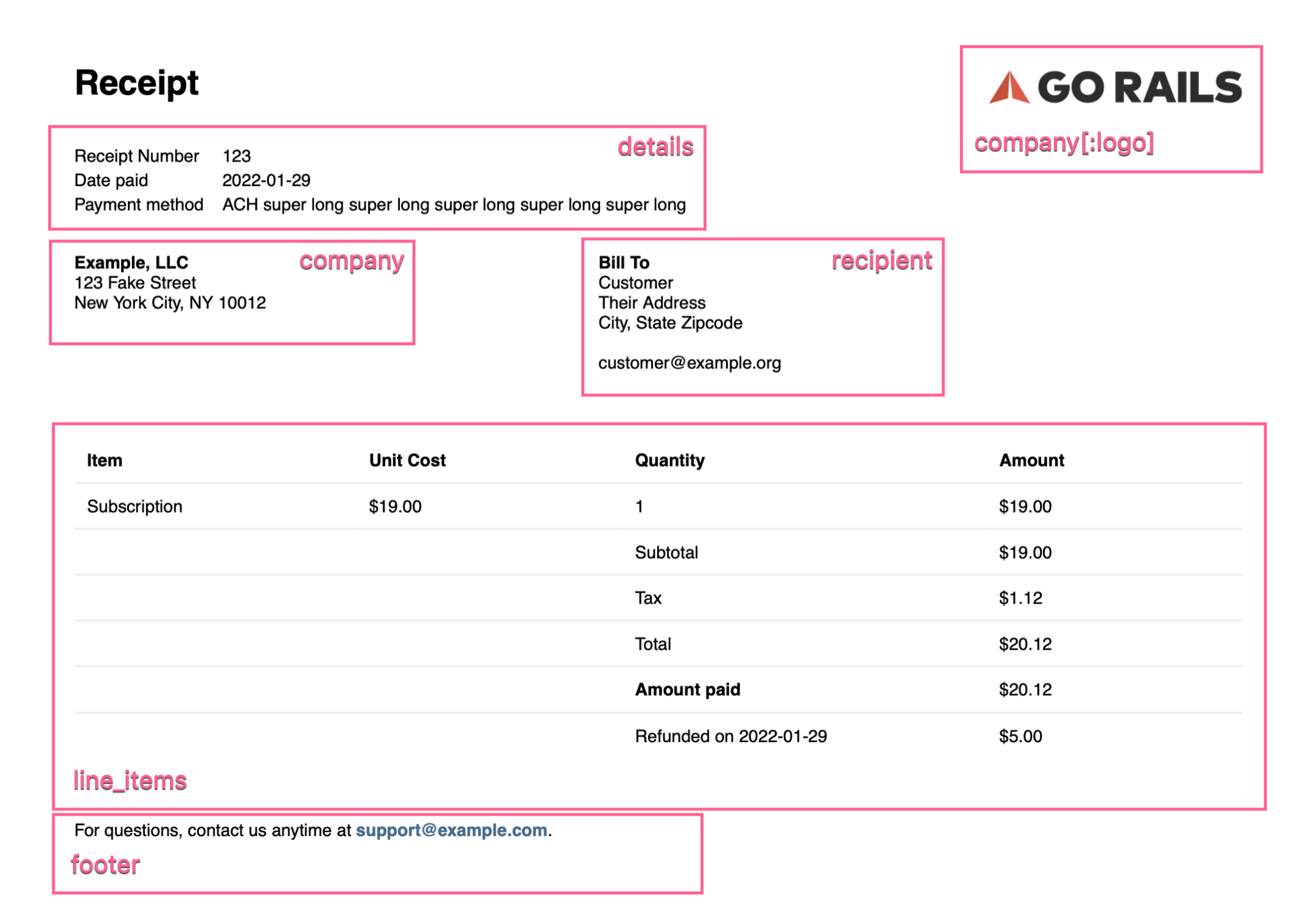Receipts, Invoices, and Statements for your Rails application that works with any payment provider. Receipts uses Prawn to generate the PDFs.
Check out the example PDFs.
Add this line to your application's Gemfile:
gem 'receipts'And then execute:
$ bundle
Or install it yourself as:
$ gem install receipts
To generate a Receipt, Invoice, or Statement, create an instance and provide content to render:
r = Receipts::Receipt.new(
details: [
["Receipt Number", "123"],
["Date paid", Date.today],
["Payment method", "ACH super long super long super long super long super long"]
],
company: {
name: "Example, LLC",
address: "123 Fake Street\nNew York City, NY 10012",
email: "support@example.com",
logo: File.expand_path("./examples/images/logo.png")
},
recipient: [
"Customer",
"Their Address",
"City, State Zipcode",
nil,
"customer@example.org"
],
line_items: [
["<b>Item</b>", "<b>Unit Cost</b>", "<b>Quantity</b>", "<b>Amount</b>"],
["Subscription", "$19.00", "1", "$19.00"],
[nil, nil, "Subtotal", "$19.00"],
[nil, nil, "Tax", "$1.12"],
[nil, nil, "Total", "$20.12"],
[nil, nil, "<b>Amount paid</b>", "$20.12"],
[nil, nil, "Refunded on #{Date.today}", "$5.00"]
],
footer: "Thanks for your business. Please contact us if you have any questions."
)
# Returns a string of the raw PDF
r.render
# Writes the PDF to disk
r.render_file "examples/receipt.pdf"You can specify the default font for all PDFs by defining the following in an initializer:
Receipts.default_font = {
bold: Rails.root.join('app/assets/fonts/tradegothic/TradeGothic-Bold.ttf'),
normal: Rails.root.join('app/assets/fonts/tradegothic/TradeGothic.ttf'),
}You can pass the following options to generate a PDF:
-
recipient- Array of customer details to include. Typically, this is name, address, email, VAT ID, etc. -
company- Hash of your company details-
name- Company name -
address- Company address -
email- Company support email address -
phone- Company phone number - Optional -
logo- Logo to be displayed on the receipt - Optional This can be either a Path, File, StringIO, or URL. Here are a few examples:logo: Rails.root.join("app/assets/images/logo.png") logo: File.expand_path("./logo.png") logo: File.open("app/assets/images/logo.png", "rb") logo: "https://www.ruby-lang.org/images/header-ruby-logo@2x.png" # Downloaded with OpenURI
-
-
details- Array of details about the Receipt, Invoice, Statement. Typically, this is receipt numbers, issue date, due date, status, etc. -
line_items- Array of line items to be displayed in table format. -
footer- String for a message at the bottom of the PDF. -
font- Hash of paths to font files - Optionalfont: { bold: Rails.root.join('app/assets/fonts/tradegothic/TradeGothic-Bold.ttf'), normal: Rails.root.join('app/assets/fonts/tradegothic/TradeGothic.ttf'), }
-
logo_height- An integer value of how tall the logo should be. Defaults to16
Here's an example of where each option is displayed.
details and line_items allow inline formatting with Prawn. This allows you to use HTML tags to format text: <b> <i> <u> <strikethrough> <sub> <sup> <font> <color> <link>
See the Prawn docs for more information.
You can specify a different page size by passing in the page_size keyword argument:
receipt = Receipts::Receipt.new page_size: "A4"You can use I18n.t when rendering your receipts to internationalize them.
line_items: [
[I18n.t("receipts.date"), created_at.to_s],
[I18n.t("receipts.product"), "GoRails"],
[I18n.t("receipts.transaction"), uuid]
]You can change the entire PDF content by instantiating an Receipts object without any options.
receipt = Receipts::Receipt.new # creates an empty PDFEach Receipts object inherits from Prawn::Document. This allows you to choose what is rendered and include any custom Prawn content you like.
receipt.text("hello world")You can also use the Receipts helpers in your custom PDFs at the current cursor position.
receipt.text("Custom header")
receipt.render_line_items([
["my line items"]
])
receipt.render_footer("This is a custom footer using the Receipts helper")To render a PDF in memory, use render. This is recommended for serving PDFs in your Rails controllers.
receipt.renderTo render a PDF to disk, use render_file:
receipt.render_file "receipt.pdf"Here's an example Rails controller action you can use for serving PDFs. We'll first look up the database record for the Charge we want to render a receipt for.
The Charge model has a receipt method that returns a Receipts::Receipt instance with all the receipt data filled out.
Then we can render to generate the PDF in memory. This produces a String with the raw PDF data in it.
Using send_data from Rails, we can send the PDF contents and provide the browser with a recommended filename, content type and disposition.
class ChargesController < ApplicationController
before_action :authenticate_user!
before_action :set_charge
def show
respond_to do |format|
format.pdf { send_pdf }
end
end
private
def set_charge
@charge = current_user.charges.find(params[:id])
end
def send_pdf
# Render the PDF in memory and send as the response
send_data @charge.receipt.render,
filename: "#{@charge.created_at.strftime("%Y-%m-%d")}-gorails-receipt.pdf",
type: "application/pdf",
disposition: :inline # or :attachment to download
end
endThen, just link_to to your charge with the format of pdf. For example:
# config/routes.rb
resources :charges<%= link_to "View Receipt", charge_path(@charge, format: :pdf) %>Invoices follow the exact same set of steps as above. You'll simply want to modify the details to include other information for the Invoice such as the Issue Date, Due Date, etc.
Receipts::Invoice.new(
details: [
["Invoice Number", "123"],
["Issue Date", Date.today.strftime("%B %d, %Y")],
["Due Date", Date.today.strftime("%B %d, %Y")],
["Status", "<b><color rgb='#5eba7d'>PAID</color></b>"]
],
recipient: [
"<b>Bill To</b>",
"Customer",
"Address",
"City, State Zipcode",
"customer@example.org"
],
company: {
name: "Example, LLC",
address: "123 Fake Street\nNew York City, NY 10012",
phone: "(555) 867-5309",
email: "support@example.com",
logo: File.expand_path("./examples/images/logo.png")
},
line_items: [
["<b>Item</b>", "<b>Unit Cost</b>", "<b>Quantity</b>", "<b>Amount</b>"],
["Subscription", "$19.00", "1", "$19.00"],
[nil, nil, "Subtotal", "$19.00"],
[nil, nil, "Tax Rate", "0%"],
[nil, nil, "Amount Due", "$19.00"]
]
)Statements follow the exact same set of steps as above. You'll simply want to modify the details to include other information for the Invoice such as the Issue Date, Start and End Dates, etc.
Receipts::Statement.new(
details: [
["Statement Number", "123"],
["Issue Date", Date.today.strftime("%B %d, %Y")],
["Period", "#{(Date.today - 30).strftime("%B %d, %Y")} - #{Date.today.strftime("%B %d, %Y")}"]
],
recipient: [
"<b>Bill To</b>",
"Customer",
"Address",
"City, State Zipcode",
"customer@example.org"
],
company: {
name: "Example, LLC",
address: "123 Fake Street\nNew York City, NY 10012",
email: "support@example.com",
phone: "(555) 867-5309",
logo: File.expand_path("./examples/images/logo.png")
},
line_items: [
["<b>Item</b>", "<b>Unit Cost</b>", "<b>Quantity</b>", "<b>Amount</b>"],
["Subscription", "$19.00", "1", "$19.00"],
[nil, nil, "Subtotal", "$19.00"],
[nil, nil, "Tax Rate", "0%"],
[nil, nil, "Total", "$19.00"]
]
)- Fork it ( https://github.com/excid3/receipts/fork )
- Create your feature branch (
git checkout -b my-new-feature) - Commit your changes (
git commit -am 'Add some feature') - Push to the branch (
git push origin my-new-feature) - Create a new Pull Request
